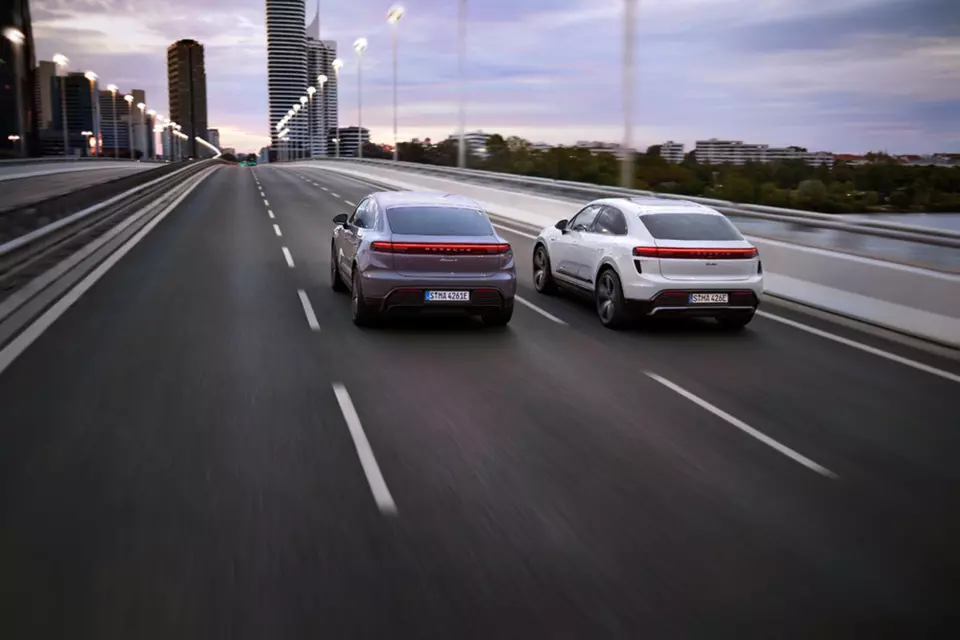All-electric Macan: superior range, charging & performance marks.
Ferdinand Porsche crafted iconic cars – the ground-breaking VW Beetle in the 1930s and the futuristic 911 in the 1960s. Testament to his vision, both live on as the VW Group transitions its Porsche marque into 21st century technology that the pioneer engineer could not have imagined: fully electric vehicles.
Greg Clarke has worked with the prestige German sports car brand since 2005 and been General Manager of Porsche NZ since 2012. As the company launches its new all-electric Macan series – the first Porsche internal combustion engine model to experience a complete powertrain switch – he says you can still see the outline of the classic 911 style.
Just back from Singapore where he and team members attended the car’s international launch, he says Porsche introduced its first fully electric model, the Taycan, in 2019-20, after earlier plug-in hybrids, and expects 70-80 per cent of its range to be fully electric or hybrid by 2028.
“Unlike a lot of other brands, we’re looking to transition the existing model series from internal combustion engines to electric rather than building completely new models, which helps us to make the change much more quickly.”
Porsche fans, known for their loyalty to the black-horse badge, needn’t fear that means losing its much-loved style: “The Porsche design leans very easily into an electric car. If you think of the classic 911, which is a rear-engine car, you don't have monster grilles in the front for a radiator – you have the Porsche styling with that very sleek low nose that can work with both combustion and non-combustion vehicles.”
The new electric Macan, available to pre-order now in the basic 4 or a higher-spec’d Turbo variant, looks very much like the petrol car. “Obviously it doesn’t have the gaps at the front for air cooling, but it doesn't look specifically like an electric vehicle,” Clarke says.
“While the mode of power has changed and the car has been refined and improved and modernised, the basic silhouette is still the same. Those key design characteristics that are on all Porsches come through every time. In the flesh it is an absolutely stunning vehicle,” Clarke says.
For Porsche’s contemporary engineers, one of the key criteria was to ensure a greater range, he adds: “It’s hugely advantageous over previous generations of electric cars. For the Macan 4, the WLTP (Worldwide Harmonised Light-Duty Vehicle Test Procedure) is just over 600km and the Turbo is just under that. In the real world, I would expect it's going to be somewhere between 500-550 km because what you're using inside the car - heated seats, air conditioning, and the driving conditions, those sorts of things - affect your driving range.
“We know there's range anxiety and we know that, when people are on a trip, they don't want to have to sit around for a long time to recharge the car.
“Because it works on 800-volt architecture, you can charge this vehicle very quickly. If you're using a high-powered DC charger – the most powerful ones in the country, the 300kw chargers – you can basically charge from 10 to 80 per cent in around 20 minutes.
“As the 300kw charging network grows around New Zealand, that gives you the ability to stop, plug it in, go and grab a coffee, and by the time you come back, you're back on your way again.”
In fact, a Macan owner driving from Auckland to the Coromandel or Omaha beaches for the weekend will get there and back without charging the car.
“Most charging, we know, will take place at home. We provide a Porsche charger and link the owner up with the provider to wire it into their house. Think of the electric car more like your mobile phone - pull into your garage and plug it in. Charging overnight, when the power supply is more readily available and cheaper, makes it very efficient.”
Porsche nicknames its Macan and sibling, the Cayenne, “four-door sports cars” rather than SUVs. That, Clarke says, is reflected in the driving experience.
While the new Macan has a slightly longer wheelbase than the previous model, and is slightly heavier because of the batteries, “the centre of gravity is much lower and the benefit of that is much improved handling and increased performance.”
A rear-wheel steering option is particularly beneficial around town because it decreases the turning circle and eases parking in tight spots. Move to change lanes on the highway, Clarke says, and the wheels turn in the opposite direction to keep the car level and in balance. “So you've got improved handling at speed and improved usability around town or parking.”
On the Porsche website Car Configurator, prospective owners can click into the new electric Macan and choose from myriad options to set up the car as they want. At one of four NZ Porsche Centres, the team will discuss purchase options and load that virtual vehicle into the real-world factory ordering system.
The first Macans are expected in the country around October-November – just in time for that Christmas trip to the beach.
VITAL STATISTICS
- 2024 Porsche Macan EV
- 100kWh battery, DC fast charging up to 270kWh, 10-80% 21min
- Length 4,784 mm Width 1,938 mm Height 1,622 mm Wheelbase 2,893 mm
- Delivery expected October-November 2024
Variants Macan 4 (base model), Macan Turbo (performance)
Macan 4 up to 285KW, 648Nm torque
- Acceleration 0-96km/h 4.9sec Top speed 219km/h
- WLTP Combined Range 516-613km
- Price from $166,500
Macan Turbo up to 470kW, 1128Nm torque
- Acceleration 0-96km/h 3.1 sec Top speed 259km/h
- WLTP Combined Range 518-591km
- Price from $223,000
Please visit: porsche.co.nz






